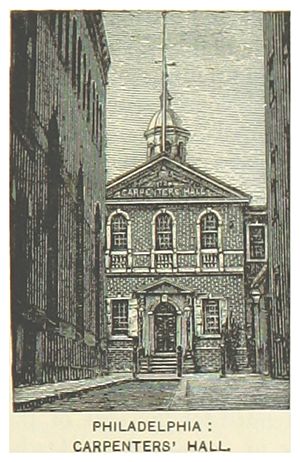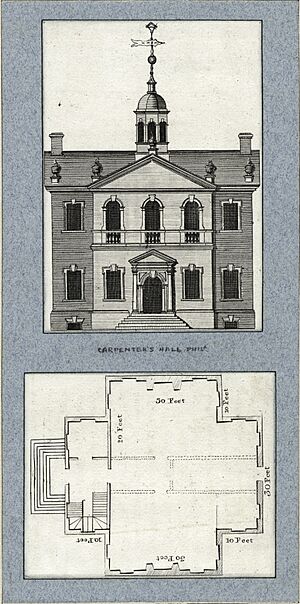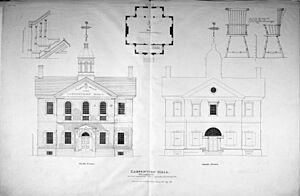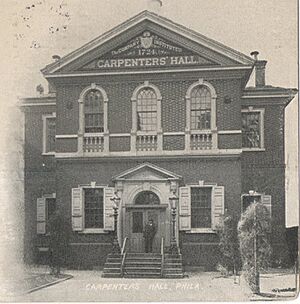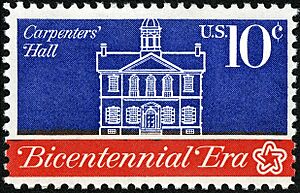Carpenters' Hall facts for kids
|
Carpenters' Hall
|
|
|
U.S. Historic district
Contributing property |
|
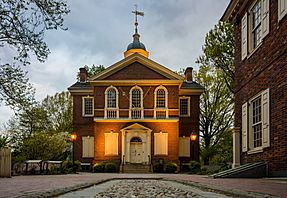
Carpenters' Hall in May 2015
|
|
| Location | 320 Chestnut Street Philadelphia, Pennsylvania, U.S. |
|---|---|
| Built | 1775 |
| Architect | Robert Smith |
| Architectural style | Georgian |
| NRHP reference No. | 70000552 |
Quick facts for kids Significant dates |
|
| Added to NRHP | April 15, 1970 |
| Designated NHL | April 15, 1970 |
Carpenters' Hall is a very important building in Philadelphia, Pennsylvania. It's located in Independence National Historical Park. This historic hall is known as the official birthplace of the state of Pennsylvania. It was also a key meeting spot for leaders during the early days of the American Revolution.
The building was finished in 1775. It's a two-story brick hall that still belongs to the Carpenters' Company of the City and County of Philadelphia. This group is the oldest craft guild in the country that is still active today.
Many important events happened here. In 1774, the First Continental Congress met at Carpenters' Hall. They created and signed an agreement called the Continental Association. Later, in June 1776, the Pennsylvania Provincial Conference met here. They officially declared that Pennsylvania was independent from the British Empire. They also helped get the Pennsylvania militia ready for the American Revolutionary War. This meeting also set up the process for creating the Pennsylvania Constitution of 1776. This constitution helped make it possible for the Declaration of Independence to be written and approved.
The British Army briefly took over the hall in 1777 during the war. Because of its importance, Carpenters' Hall was named a National Historic Landmark on April 15, 1970. In 1982, the state of Pennsylvania officially recognized Carpenters' Hall as the birthplace of the Commonwealth of Pennsylvania.
Today, you can visit Carpenters' Hall for free. About 120,000 people visit each year. Many important people have visited, including kings, queens, presidents, and governors.
Contents
History of Carpenters' Hall
Building the Hall
The Carpenters' Company was started in 1724. But for a long time, they didn't have their own meeting place. They had to rent rooms in taverns. In 1768, members of the Carpenters' Company bought the land on Chestnut Street. This was just a short walk from Benjamin Franklin's home.
The hall was designed by an architect named Robert Smith. He designed it in the Georgian style. This style was popular in Scotland, where Smith was born, and also used in Italy. The decision to build the hall was made in January 1770. Construction was finished in August 1774. The Carpenters' Company held their first meeting in their new hall on January 21, 1771. They continued to meet there until 1777.
Key Meetings and Events
The First Continental Congress met at Carpenters' Hall from September 5 to October 26, 1774. This was a very important meeting for the Thirteen Colonies in North America. During this meeting, they decided to stop importing enslaved people. They also agreed to end the slave trade within the colonies. This was an early step towards ending slavery in British North America. They also created and signed the Continental Association. This was an agreement to boycott British goods.
In June 1776, another crucial meeting took place at Carpenters' Hall. The Pennsylvania Provincial Conference declared Pennsylvania's independence from the British Empire. They also prepared the Pennsylvania militia for the American Revolutionary War. This meeting helped set up the process for creating the Pennsylvania Constitution of 1776.
The Second Continental Congress met nearby in what is now Independence Hall. In 1775, they created the Continental Army. They also chose George Washington to lead it. The next year, in July 1776, the Second Continental Congress approved the Declaration of Independence. Thomas Jefferson wrote most of this important document. He wrote it from his apartment on Market Street, which was close to Carpenters' Hall.
From September 1777 to June 1778, the British Army occupied Philadelphia, including Carpenters' Hall. During the Revolutionary War, the hall was even used as a hospital for both British and American soldiers.
Over the years, other important groups also met at Carpenters' Hall. These included Ben Franklin's Library Company of Philadelphia and the American Philosophical Society. The First and Second Banks of the United States also held meetings there.
Later History
From 1802 to 1819, Carpenters' Hall was used as the federal Custom House in Philadelphia. This is where taxes on imported goods were collected.
In 1970, Carpenters' Hall was officially recognized as a National Historic Landmark. This means it's a place of great historical importance to the United States. On November 30, 1982, the state of Pennsylvania officially declared Carpenters' Hall as the birthplace of the Commonwealth of Pennsylvania.
Inscription
Above the south door of Carpenters' Hall, there is an inscription.
See also
 In Spanish: Carpenters' Hall para niños
In Spanish: Carpenters' Hall para niños
- Continental Association, an important document from 1774 that helped start a trade boycott with Great Britain.
- List of National Historic Landmarks in Philadelphia
- National Register of Historic Places listings in Center City, Philadelphia
- Founding Fathers of the United States


